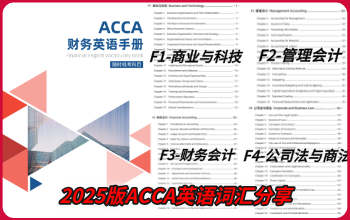
通过ACCA考试科目P1的诀窍是“知识+理解” ,所谓的“理解”,是以考试的案例为基础的,死记硬背肯定不行。ACCA题库,戳:ACCA题库【手机可刷+全球题库】(按照知识点进行分类配题,有知识点没有搞懂,无法解锁,直至掌握,目前阶段免费)
下面是一些小诀窍:
· 按设问要求写答案,而不要写一些无关的信息,以便更好的时间管理。
· 每题都有最多得分,不是罗列越多越好。比如,一道10分的题目,考生应该在案例中找与之相关的5个点,解释为什么他们与案例相关,进而分析。而不是找太多的点进行罗列或抄录。
· 学习去案例中找证据,以支持分析答案,解决问题,时间规划。并且,考前多多做题,多多练习。
ACCA exam tips 不是用来给你押题的,是汇总本次考试的重要关键信息。文中有部分知识点的整理,更重要的是考试答题技巧的汇总,以及考前准备。押题复习不可取,大家借助本文参考资深考官给出的考试答题技巧更加重要。备考的你一定要全面复习!
12月 ACCA考试科目P1 Tips
Kaplan
Each P1 paper offers 4-6 marks for displaying professional skills, which can easily be the difference between a pass and a fail. The marks are available for both format and the tone and style of your answer, where you may have to prepare a speech or write a letter on behalf of the Board addressing specific concerns. Take a look at the Article of 24 August 2009 for more guidance and some great hints on style.
ACCA考试科目P1 is a very wordy paper, and the examiner wants to ensure that you have a good grasp of the theories behind the questions, but also that you can successfully apply the theories to given scenarios. Therefore, it is very easy to get lost within a question if your layout and approach to a question is poor.
A good approach is to apply 3 rules in your answer:
Introduction – this should be very short, but can help you get over any ‘writers block’。 It might include a read back of the question, or a definition of the subject matter (for example, if the question asks for the roles of NED’s, start by very quickly defining what an NED is)
Theory – this section will show the examiner that you actually understand the issue being questioned, again, as with the introduction, this should really be kept short, it can be a section quote from the code, or a reference to an author (Cadbury or Greenbury et al)。
Application – This will be the main bulk of your answer and should relate directly to the scenario. This is often the most difficult section of the answer, but should be made easier by the use of the introduction and theory sections.
In addition remember the golden rules of written questions:
Following are some of the famous topics that were tested in past
BPP
Section A:
One compulsory question worth 50 marks which uses a lengthy scenario, often based on real-life events, to test all three main syllabus areas. Typically, this consists of four written requirements, some of which may be broken down into smaller sub-requirements where discrete syllabus content will be tested both as knowledge and application.
Within the total of 50 marks, there will be 4 professional marks available for producing some form of written communication (such as a briefing note, press release or letter to shareholders) which tests a candidate’s ability to write logical, structured and appropriate content suitable for a particular purpose, often with the aim of presenting a certain point of view.
Section B:
A choice of two from three written questions each worth 25 marks and which typically each test up to two syllabus areas by applying the syllabus to a smaller real-world scenario. Again, candidates will be expected to apply their knowledge to the scenario in order to score well.
P1 has the following syllabus areas:
General advice:
ACCA students are no longer given a separate period of 15 minutes ‘reading and planning’ time at the start of each written exam as the exam duration is now 3 hours and 15 minutes to include reading, planning and writing. However, we would still advise you to use a period similar to this at the start of the exam to continue planning the things you need to include in your answer. It is essential that you use the information in each scenario to make your answers relevant – due to the typical size of the compulsory scenario, we would advise that you still use this notional 15 minutes to plan this question above all others.
During this time you should also think about how you will produce your answer – pay attention to the verbs used in question requirements as these indicate the number of marks available. For example, the verb “explain” requires a sentence and will score one mark if properly explained whereas the verb “list” simply requires you to present information with no further explanation: this will typically only score ½ mark per point listed.
Recent exams have tested content from the examiner’s technical articles (such as June 2015 on corporate social responsibility (CSR) strategy and strategic CSR) so you should ensure you are familiar with any new articles that have recently been published just in case – they can be found here: http://www.accaglobal.com/gb/en/student/exam-supportresources/professional-exams-study-resources/p1/technical-articles.html
You can expect to see the use of stakeholder, ethical and other CSR theories applied to scenarios, as well as the use of risk, control and governance syllabus content, especially relating to board directors, remuneration and reporting – you should be aiming to attempt as many past-paper questions as possible, especially those focusing on dysfunctional behaviour in areas such as bribery and corruption, environmental risk or poor ethical stance.
ACCA题库,戳:ACCA题库【手机可刷+全球题库】(按照知识点进行分类配题,有知识点没有搞懂,无法解锁,直至掌握,目前阶段免费)



 考经分享
考经分享
 发布时间:2017-12-01
发布时间:2017-12-01


 复制本文链接
复制本文链接 模拟题库
模拟题库

 323
323

























